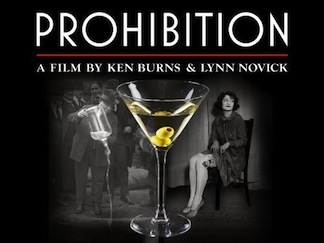Using the History of Prohibition to Understand Contemporary Corruption
 It is a truism that to understand where we are, one must understand where we were.
It is a truism that to understand where we are, one must understand where we were.
For folks who wonder just how the American system of alcohol control and regulation became the protectionist racket it currently is and how wholesaler middlemen in every state came to control which laws and regulations are enacted, you could do much worse than watching Ken Burns' new three part documentary, "Prohibition".
The first installment of "Prohibition" aired last night and undertook to explain the historical relationship Americans had with alcohol in pre-Prohibition America as well as the various movements spawned by the abuse of the product.
As one would expect with a Burns production, the viewer is exposed to impressive documentary evidence of the subject matter and in this case we see vividly how alcohol became entwined into the American culture. We see the horrific results of what happens when immigration and an increased in single, working males combines with the saloon being the center of social life. We see how people and family were destroyed by obscenely irresponsible marketing practices by brewers in urban areas that controlled the saloon culture.
If you watch this new documentary on Prohibition, do so with the following in mind: when Prohibition ended in 1933, it was of primary importance to policy makers to re-regulate alcohol with a mind to avoiding the conditions and circumstances that existed prior to prohibition. Put another way, in large part, today's system of alcohol regulation—particularly the three tier system—was devised to prevent the return of conditions that existed 100 years or more ago.
The primary pre-Prohibition villain that motivated policy makers when Prohibition ended was the "tied house". This commercial invention amounted to brewers financing saloon owners by paying to set up and maintain saloon owners in exchange for the saloons only serving a single brewer's suds. Brewers demanded continually increased sales. This led to marketing practices that encouraged over consumption. It was a disaster for propriety, civic good will, families, and temperance.
One way to assure tied house relationships did not develop after Prohibition ended was to outlaw any ownership or involvement by producers of alcohol with sellers of alcohol. This was done by mandating that producer sell to wholesales, who in turn would be charged with selling to retailers, saloons and restaurants.
Of course, this simply transferred the power to corrupt from producers to wholesales, which has taken hold completely across the country today where wholesalers now largely control what products retailers and restaurants may sell and how much of it they may sell. It also has led to wholesalers corruptly controlling the legislative and regulatory process behind alcohol laws, rather than producers.
Over the next two episodes of "Prohibition", Burns will, I presume, examine social, criminal and cultural systems that developed during Prohibition, as well as the movement that led to Prohibition's demise. Based on the first installment of the documentary, I have high hopes for the following two installments.

I watched it and was riveted to the TV, which rarely happens. In order to bring some restraint the pendulum had to swing far to the other side unfortunately. It is all a matter of balance.
Another unfortunate situation is that politicians cannot see or understand the law of unintended consequences.
The other result of Repeal was that state regulation of alcohol was generally implemented to 1. create and control the tax revenue stream (hence the three tier system gives states an easier method to collect taxes) and 2. to make alcohol difficult for consumers to get their hands on.
The states don’t change things because under the system, each goal has been met.
As for Burns’ documentary: Tom, I wouldn’t count on the ending to go after the three tier system–unless you had a hand in the third episode 😉
I did wonder last night why the documentary stated that the temperance movement began in 1843; it began about a decade before then.
Thomas:
Indeed, the actions taken by policy makers post-prohibition had many aims. Tax collection was one as well as temperance. Also, trying to move organized crime out of the process was another.
The problem with the currently control systems is that they have been hijacked by special interests that are unwilling to face numerous elements of reality.
The fact is, one could easily reform alcohol control today to make it more effective, more responsive, more consumer friendly, and still achieve every single goal that was originally sought. However, even better would be to reformulate the goals of alcohol control and regulation.
Oh I’m sorry I missed this! Thank you for the recap =)
Tom posted: “Also, trying to move organized crime out of the process was another.”
I’m not so sure about that. After Repeal, organized crime outfits became legal distributors in many states.
As for: “…even better would be to reformulate the goals of alcohol control and regulation.”
To be sure.
Drat! I wanted to see this, and I want to see the rest of it too. Does anyone know what the air schedule is?
I’m reminded of a crack made by the late George V. Higgins, author of “The Friends Of Eddie Coyle” and many other crime novels. When asked whether he thought the Mob was moving into legitimate business, he’d answer “I certainly hope so!”
Anyway, I knew you’d be all over this one. I don’t have TV, so I’m going to have to wait for it to appear in downloadable/DVD form…